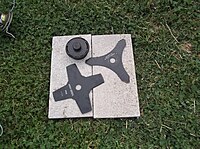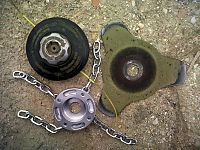|
Brushcutter (garden tool) A brushcutter (also called a brush saw, clearing saw or gasoline goat) is a powered garden or agricultural tool used to trim weeds, small trees, and other foliage not accessible by a lawn mower or rotary mower. Various blades or trimmer heads can be attached to the machine for specific applications. It consists of:
Power unitsThere are three main types of power unit:[citation needed]
ShaftThere are three types of shaft:[citation needed]
 Handles vary on brush cutters, depending on the weight and size of the unit. Larger, more powerful brushcutters employ handlebars — a handle on either side of the shaft, similar to bike handlebars — whilst smaller units use a D-shaped handle mounted on the shaft. Heavier saws usually require a harness for safety and reduced fatigue. The shaft on units requiring a harness will have multiple attachment points, so that the entire unit may be adjusted and balanced by users of differing height.[citation needed] Cutting headCutting heads include circular saw blades (chisel tooth or scratcher tooth), brush knives, grass blades, etc. Most brushcutters also allow other heads to be fitted, including bump feed and fixed line heads such as those used on line trimmers or modified saw blades such as a beaver blade which resembles a chainsaw. Deflectors are attached on the cutting side of the machine to prevent injury to the operator from debris thrown by the cutting head.[citation needed] Plastic or metal flails can be used for cutting stems too large for a line head but not requiring a blade. Following an incident in the UK in which when a metal chain link thrown from an aftermarket flail killed a bystander, all flail heads are now banned in the EU.[1][2] References
|

